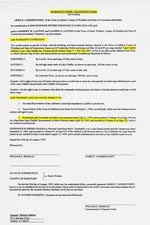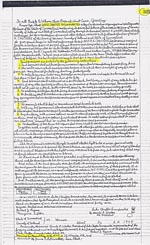COVENANTS
Deeded Covenants
Deeds within the Lake Chaffee community are subject to a set of ten (10) covenants (sometimes referred to as "restrictive covenants").
These covenants are a contract to which each Lake Chaffee property owner agreed, knowingly or unknowingly, at the time of purchase.
It is the responsibility of the LCIA Board of Directors to "...make reasonable assumptions in interpreting the restriction and to what circumstance it applies..."1
- Said premises shall not be used for any commercial, agricultural or manufacturing business of any kind.
- The water upon which said premises borders or to which there is a right of way for said premises, may be used for bathing, boating, fishing only.
- No outside privy or toilet may be erected on said premises and septic tanks must not be less than 75 feet from the shore line of the lake.
- Said premises shall not be used as a public beach, boat livery or right of way to the lake for owners of any other property within ten mile radius of the premises conveyed. The said premises shall not be used as a beach, public or private, except by the owner, his relatives or visiting guests.
- No water may be taken from the lake for any business purposes, commercial, manufacturing or agricultural.
- No building shall be erected on said premises except a one family dwelling house and private garage. Any garage erected on said premises must conform in general appearance and material to any dwelling on said premises.
- No animals shall be kept or maintained except household pets.
- Nothing but permanent structures shall be erected upon said premises. No trailers or tents shall be placed upon said premises except by written permission of the Board of Directors of Lake Chaffee Incorporated.
- Any building with a wood exterior must be stained or painted with at least two coats of paint or stain, and no tar paper exterior finish shall be used. No metal exterior finish shall be used nor shall any "Quonset hut" so-called, be erected upon said premises.
- No dwelling of less than 480 square feet area shall be erected upon said premises.
"A RESTRICTIVE COVENANT is a clause in a deed or lease to real property that limits what the owner of the land or lease can do with the property. Restrictive covenants allow surrounding property owners, who have similar covenants in their deeds, to enforce the terms of the covenants in a court of law. They are intended to enhance property values by controlling development.
"Land developers typically use restrictive covenants when they subdivide property for residential developments. A land developer, after platting the subdivision into lots, blocks, and streets, will impose certain limitations on the use of the lots in the development. These may include a provision restricting construction to single-family dwellings with no detached outbuildings, as well as specifying that the dwellings are to be built at least a specified distance from the street and from the side and back lot lines, commonly called a "set back" requirement. Another common restrictive covenant specifies a minimum square footage for dwellings. There may be a variety of other restrictive covenants that seek to control the way the development looks and is maintained. These covenants are filed with the approved plat.
"A person who purchases a lot in a development with restrictive covenants must honor the limitations. When the purchaser resells the lot to a buyer, the new owner will take the property subject to the restrictive covenants, because the covenants are said to "run with the land."
"If a person violates or attempts to violate one or more of the covenants, a person who is benefited by the covenants, usually an adjacent property owner, may sue to enforce the restrictions. Courts generally strictly construe restrictive covenants to allow a landowner to use her land for any purpose that is not specifically prohibited by the restrictive covenants or by the local government. Therefore, if a developer wants to restrict a subdivision to single-family residences, the developer must state "single family residential" rather than "residential" in the covenant."2
In General Guide to Restrictive Covenant Enforcement Attorney William G. Gammon writes, "Generally, and in most cases, it is the Board of Director's (the "Board's") fiduciary duty to enforce the deed restrictions on behalf of the Association membership."
1Goodwwin and Paul letter to Laura Koropatkin et al dated July 6, 2007; page 3 paragraph 1.
2The Free Dictionary by Farlex



